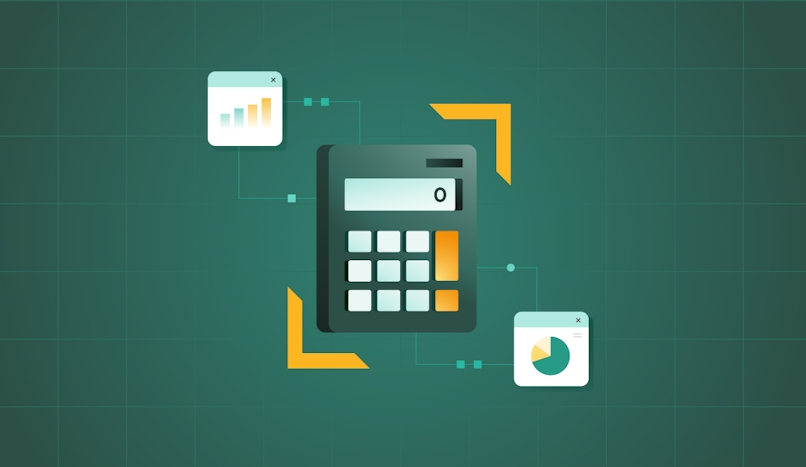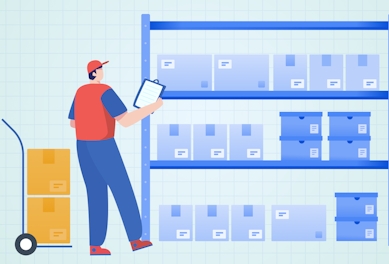Inventory Levels: What They Are, and 5 Ways to Manage Them
Learn what inventory levels are and how to manage them effectively. These pro tips can improve your supply chain efficiency and profitability in 2023.

Track inventory all the way to your customer’s door and promote timely delivery with Circuits for Teams.
Inventory management is critical to running any successful business, and maintaining optimal inventory levels is key to achieving profitability and customer satisfaction. Let’s explore inventory levels and effective ways to manage them.
Key takeaways
- Effective inventory management is essential for excellent customer service, reduced costs, and maximum profit.
- Understanding your inventory needs can minimize profit loss due to storage costs, dead stock, and lost sales.
- The top ways to manage your inventory levels are by using an inventory management system, forecasting demand, calculating inventory levels, optimizing order quantities, and conducting regular inventory audits.
- Calculate inventory levels by measuring economic order quantity (EOQ), minimum order quantity (MOQ), reorder point, minimum order lead time, minimum consumption, and normal consumption.

What are inventory levels?
“Inventory levels” refer to the quantity of goods a business holds in stock at any given time. It also prevents overstocking, which ties up valuable resources and may increase inventory costs.
Managing and tracking inventory levels is crucial for supply chain management because it helps you make sure the right amount of inventory is available at the right time to meet customer demand.
Types of inventory
Consider these inventory types when managing your inventory levels:
- Safety stock is extra inventory that can meet unexpected demand or assist with supply chain disruptions. For example, a company may hold higher stock levels during a seasonal peak or in anticipation of a supplier delay.
- Cycle stock is the average inventory regularly used to meet expected demand based on historical sales data and future demand projections. For instance, a bakery may keep a certain amount of flour and sugar on hand to produce daily baked goods.
- Buffer stock is the inventory held between different production stages to make sure the next stage has sufficient materials. For example, a manufacturing plant may hold a buffer stock of raw materials to avoid low inventory levels and send a steady supply to the production line.
Benefits of managing inventory levels
Effective inventory control can help your business in many ways. Let’s detail some top benefits.
Better customer service
Effective inventory management improves customer service by making sure businesses have the right SKUs (stock keeping units) in stock to meet customer demand. This reduces the likelihood of backorders or delayed deliveries. It also helps businesses respond quickly to customer inquiries about product availability and delivery times, improving customer satisfaction and loyalty.
Stand out from the competition and build a loyal customer base by making sure customers get your products when they want them.
Reduced costs
Poor inventory management can result in higher costs, reduced profitability, and even bankruptcy. One of the main costs associated with holding excess stock is holding costs, including rent, utilities, and insurance.
You can also reduce inventory obsolescence costs, including write-offs for excess inventory, discounts to clear out obsolete inventory, and disposal costs through effective inventory management. Managing inventory levels effectively can minimize the risk of obsolescence costs and improve profitability.
Similarly, stockout costs associated with insufficient inventory levels can lead to lost sales, reduced customer satisfaction, and expedited shipment costs. On the other hand, effective inventory management can reduce the risk of stockout costs and improve profitability.
In short, robust inventory management practices can help you reduce inventory costs associated with storage space, dead stock, and lost sales throughout the year.
More profit
Inventory management is crucial to your profitability. Poor inventory management can lead to excess inventory or shortages, while effective inventory management can optimize your inventory levels, reduce waste, and improve cash flow.
Excess inventory ties up your capital, adds costs like warehousing and handling, and risks your inventory becoming obsolete or spoiling. Likewise, stockouts can lead to lost sales, dissatisfied customers, and potential damage to your reputation. Obsolete inventory can reduce profits due to the costs of selling at a reduced price or, worse: disposal.
Implement effective inventory management practices to prevent these issues, achieve optimal inventory levels, reduce costs, increase revenue, and improve profitability.
5 ways to manage inventory levels

Managing and optimizing inventory levels is crucial to supply chain management. Let’s explore five effective ways to manage inventory levels and improve operations.
1. Use an inventory management system
Investing in an inventory management system can help you track inventory levels, monitor stock movement, and manage reorder points. Customizable software options are available to fit your specific business needs. Some popular options are Zoho Inventory and Fishbowl Inventory.
2. Forecast demand
Forecasting demand is crucial for inventory management and supply chain planning. It helps you keep sufficient inventory on hand to meet customer demand without excess inventory or stockouts. Simply analyze historical data (like sales records).
Spreadsheets (such as Excel or Google Sheets) can help you create basic forecasting models. You can also use more advanced statistical methods like regression analysis, time-series analysis, or machine learning algorithms to identify factors that affect demand and improve precision. For example, external factors like seasonality, weather, and economic trends can impact demand.
Demand planning software is a great way to automate demand forecasting and generate accurate forecasts using advanced algorithms and machine learning techniques.
3. Calculate inventory levels
Effective inventory management is crucial for businesses to meet customer demand and cut costs. Achieve this by calculating a few different types of inventory levels:
- Minimum inventory level (or minimum stock level) helps you avoid stockouts by keeping at least a certain amount of an item in stock.
- Maximum inventory level (or maximum stock level) prevents excess inventory and related costs by making sure you only have up to a certain amount of an item.
- Optimal inventory level balances the cost of holding inventory against the risk of stockouts, reducing waste and improving cash flow.
Monitoring and adjusting these inventory levels helps businesses increase efficiency, reduce costs, and improve customer satisfaction.
You must measure certain key metrics to calculate minimum, maximum, and optimal inventory levels:
- Economic order quantity (EOQ): This is the optimal quantity of inventory to minimize ordering and carrying costs. Calculate it using the following formula: EOQ = sqrt((2DS)/H), where D is the annual demand, S is the ordering cost per order, and H is the carrying cost per unit.
- Minimum order quantity (MOQ): This is the minimum amount of goods you can order from a supplier. You must know this to determine how much stock you’ll have on hand after placing and getting an order.
- Reorder point: This is the point at which a business needs to order more inventory to avoid stockouts. Calculate it using the following formula: Reorder point = (Lead time x Daily demand) + Safety stock, where lead time is the time it takes for inventory to arrive, daily demand is the average quantity of items customers order each day, and safety stock is the additional inventory held to reduce the risk of stockouts.
- Minimum order lead time: This is the minimum amount of time it takes for inventory to arrive after it is ordered. It is important to consider minimum order lead time when calculating minimum inventory levels, as it determines the lead time for inventory replenishment.
- Minimum consumption: This is the minimum amount of inventory consumed during a given period. Considering this helps make sure enough inventory is available to meet customer demand.
- Normal consumption: This is the average inventory consumed during a given period. Considering normal consumption when calculating optimal inventory levels is important, as it shows whether your inventory levels are optimized to meet customer demand.
4. Optimize order quantities
Optimizing order quantities means finding the best balance between ordering too much inventory (which can tie up cash flow and increase carrying costs) and ordering too little (which can result in stockouts and lost sales).
Here are some tips for determining the best reorder quantity:
- Use data. Use historical sales metrics and demand forecasting tools to estimate future demand and determine the optimal order quantity.
- Analyze carrying costs. Determine how much it costs to hold items in stock. This can help you decide how much to keep on hand.
- Consider vendor discounts. If your supplier offers discounts for larger orders, it may be cost-effective to order more inventory than you need to cut costs.
- Automate the process. Inventory management software can automate the process of calculating optimal order quantities by considering factors like lead times, reorder points, and sales forecasts.
- Continuous improvement. Continuously review and adjust your order quantities based on changing market conditions and demand patterns.
Inventory management software can automatically calculate your optimal order quantity based on factors like lead time, demand forecasts, and carrying costs. Some will also automate your ordering process by generating purchase orders and sending them to suppliers when your inventory reaches a certain level.
5. Regularly audit inventory
An inventory audit is a comprehensive inventory count to make sure your actual amount of stock matches your recorded inventory. It is an essential part of inventory management because it helps you identify discrepancies, inaccuracies, and inefficiencies in your inventory process.
Here are some tips for conducting an inventory audit:
- Establish a baseline. Before beginning the audit, create an inventory baseline by setting an inventory level as a starting point you can reference and aim for in future audits.
- Choose a method. Some common methods include spot-checking, cycle counting, and perpetual inventory.
- Verify inventory accuracy. Physically verify the inventory on hand and compare it to your recorded inventory levels.
- Analyze discrepancies. If there are discrepancies, investigate why they occurred and implement corrective measures to prevent them in the future.
- Adjust inventory records. Now is the time to make sure everything is accurate and up to date. Make changes as needed.
- Document the results. Tracking your findings during each audit will help you improve and streamline the process.
Inventory management doesn’t end at the warehouse

Your responsibility for your finished goods does not end when they leave your warehouse. They still need to reach your customers on time and in good condition, which is why delivery management is crucial.
Circuit for Teams is the perfect tool for optimizing the last-mile delivery segment of your inventory management with automated route planning, real-time driver tracking, proof of delivery, and customer communication features. Try Circuit for Teams for free today, and see how it can improve your bottom line.




